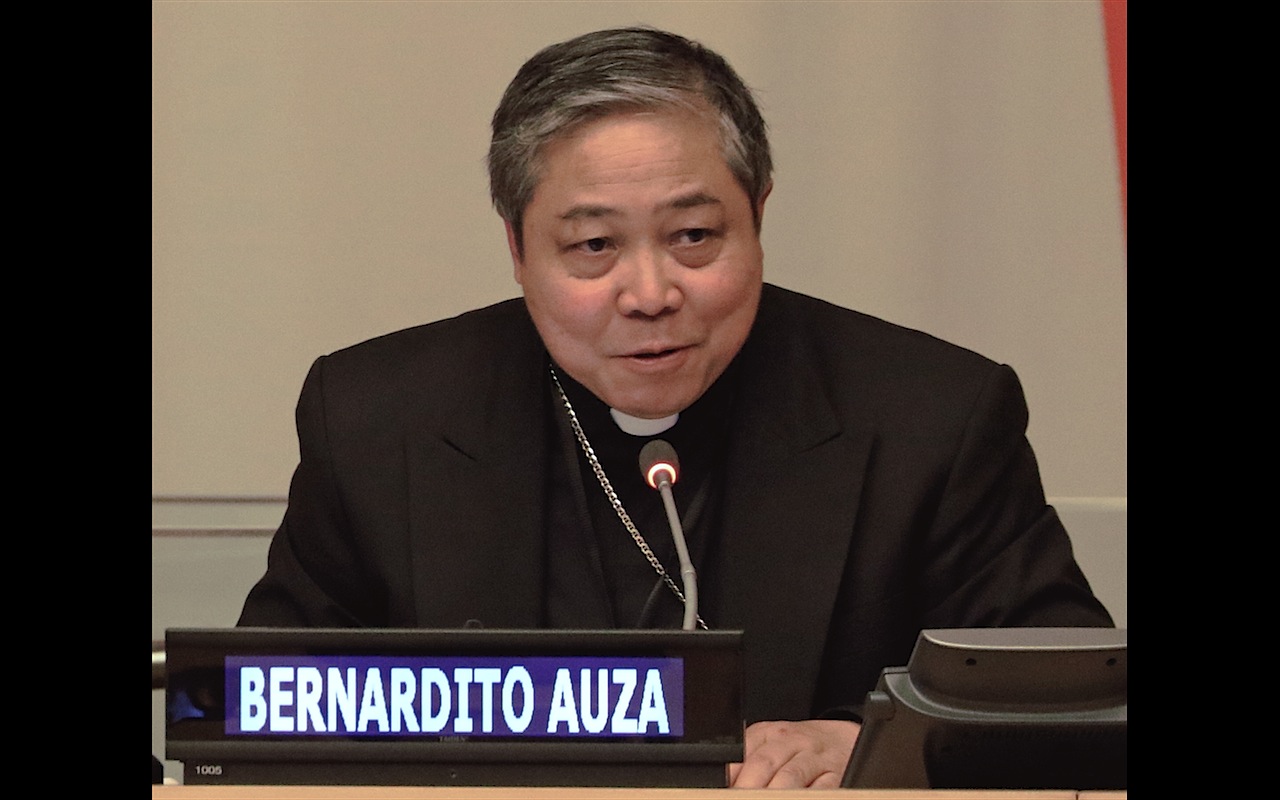“The Holy See believes that the adoption of the Treaty on the Prohibition of Nuclear Weapons brings the international community closer to a world without nuclear weapons and is a step toward the full implementation of the Non-Proliferation Treaty,” according to Archbishop Bernardito Auza, Apostolic Nuncio and Permanent Observer of the Holy See to the United Nations.
His comments came November 2, 2017, during the Fourth Committee of the 72th Session of the General Assembly, Agenda Item 51: Effects of atomic radiation, at the United Nations in New York.
“Nuclear technology is, indeed, useful in many areas of development, and thus could be a potent tool in the successful implementation of the 2030 Agenda for Sustainable Development,” the archbishop said. However, he warned that in light of the incidents at Chernobyl and Fukushima, nuclear development “needs to be carried out with an approach carefully evaluated to minimizing the risks of accidents.”
Here is the archbishop’s statement
Mr. Chair,
The Holy See commends the United Nations Scientific Committee on the Effects of Atomic Radiation (UNSCEAR) for the valuable contribution it has been making to fostering a wider knowledge and deeper understanding of the levels, effects and risks of ionizing radiation, and for fulfilling its mandate with scientific authority and independence of judgment.
For sixty-four years, UNSCEAR has provided the United Nations with information and analyses on atomic radiation, on its devastating effects when released from nuclear weapon tests and nuclear accidents, and on its role in the peaceful uses of nuclear energy. The just-concluded negotiation of the Treaty on the Prohibition of Nuclear Weapons resulted in large measure from the renewed attention paid to the catastrophic consequences of nuclear weapons. Those consequences uniquely include death and injury due to radiation when nuclear weapons would be used, as well as the radiation-caused injuries and medical effects of fallout from nuclear testing. It goes without saying that, seventy-two years after the bombing of Hiroshima and Nagasaki, the testing of nuclear weapons in the atmosphere, or the enormous catastrophe of a further use of a nuclear weapon in war, are outcomes that we must avoid with all the energy we can bring to task.
The Holy See believes that the adoption of the Treaty on the Prohibition of Nuclear Weapons brings the international community closer to a world without nuclear weapons and is a step toward the full implementation of the Non-Proliferation Treaty.
After the nuclear accidents in Chernobyl and Fukushima, it is clear that pursuing peaceful uses of nuclear energy, beyond satisfying the critical need of doing so with robust safeguards as implemented by the International Atomic Energy Agency (IAEA), needs to be carried out with an approach carefully evaluated to minimizing the risks of accidents. Lessons learned from these accidents undoubtedly serve to improve further the safety standards that regulate the peaceful uses of nuclear energy, including the safe, secure and permanent disposal of the growing amount of radioactive waste, especially the long-lived and high-level waste that poses a particular threat. Implementing these lessons is necessary for the safety and security of the populations as well as for the protection of the environment, both now and for the future. Moreover, improving the safety and protection of nuclear energy plants and sites would also be a measure to discourage terrorists from targeting them.
The Holy See thus positively notes the Director General of the International Atomic Energy Agency’s comprehensive report on the Fukushima Daiichi accident, released on May 14, 2015, taking into account the findings of the Scientific Committee as of that date.
During its Sixty-fourth Session, UNSCEAR has commendably continued its important work on epidemiological studies, on the radiation consequences of the Fukushima nuclear accident, on thyroid cancer data in the Chernobyl region, and the biological mechanisms for health effects from low-dose exposure to radiation.
Such work is relevant not only to making rapid progress in eliminating the threats to global health that nuclear explosions could cause, but to pursuing the United Nations Sustainable Development Goals. The Holy See commends and supports all those activities of UNSCEAR, the IAEA and other agencies that contribute to authentic human development and foster peace and prosperity throughout the world.
Nuclear technology is, indeed, useful in many areas of development, and thus could be a potent tool in the successful implementation of the 2030 Agenda for Sustainable Development. Nuclear technology can improve conditions of life for great numbers of people in the areas of agriculture, food safety, quality of nutrition, purity of scarce water resources, and efforts to monitor and remedy environmental pollution. Undoubtedly, the greatest successes are in the field of health care, such as in the diagnosis and treatment of many diseases. The Holy See believes that an improved public awareness and greater recognition of these significant achievements would come about through making benefits more widely available to all peoples, especially in the developing world.
Mr. Chair, the work of UNSCEAR, the IAEA and other agencies to ensure the safe uses of nuclear technology for all is critical not only to furthering a peaceful and prosperous global community, but also to helping world leaders ensure that the horrors of a nuclear war are never witnessed in our world again.
Thank you, Mr. Chair.
Copyright © 2017 Permanent Observer Mission of the Holy See to the United Nations, All rights reserved.
JF

Archbishop Bernardito Auza ©Holy See Mission
Archbishop Auza: Treaty is Move Forward
Treaty on the Prohibition of Nuclear Weapons


